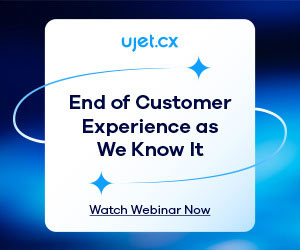Mark Ungerman at NICE CXone asks what CX is and provides a mini guide to get you started.
Knowing the answer to the question “What is CX?” is crucial for everyone who wants the people they serve to have a positive perception of their organization. Superior customer experience can drive profitability and customer loyalty, and turn satisfied customers into brand advocates.
Focusing on CX isn’t just a task for retailers. Government agencies, dentists, hospitals, car washes, and any organization that provides products and services can apply customer experience best practices to ensure customers/citizens/patients are treated to great, frictionless experiences.
But I’m getting ahead of myself. Let’s begin with a definition.
What Is CX?
Customer experience (CX) receives a lot of attention, but it’s one of those terms that doesn’t have a standard definition.
There is some variability in how business experts define it, but most definitions have some commonality – customer experience in its simplest form is the perception consumers have of a company’s brand based on their interactions with that company.
These interactions happen in multiple ways and across multiple channels. For example, a retail operation may offer the ability to order online, execute email campaigns, be active on Facebook, and have a call centre for customer service.
The experience the business offers is the sum of those touchpoints. This means each touchpoint impacts the customer.
How does the retail store look, sound, and smell? Are emails sent too frequently? Are call centre agents professional and proficient? Do all the different touchpoints offer a consistent brand experience?
Customer opinions are very personal and have a strong emotional component. Just think about the last time an interaction with an organization left you either delighted or frustrated, or even angry.
That one incident that evoked extreme emotions probably established your opinion of the organization regardless of the quality of previous interactions.
This example is why so many businesses are making CX a priority. One bad experience can send even loyal customers heading for the door.
In fact, PwC found that 32% of all customers would stop doing business with a brand they loved after one bad experience. I’ve done that before. It’s particularly disappointing when businesses you’re loyal to let you down.
An Example of Disappointing CX
It’s important to remember that CX isn’t about a single transaction or impression. People form their opinions of an organization based on a set of cumulative interactions. However, one bad apple can spoil the whole bunch, as you’ll see in the following example.
Imagine you’ve been going to your favorite neighborhood restaurant for over ten years. The food is great and made with fresh ingredients, and the prices can’t be beat.
Over the years, you’ve gotten to know the lovely restaurant owners and they even brought food out to your car so you didn’t have to drag your toddlers into the restaurant to pick up your carryout order. And then one day you crack open a Crab Rangoon and find a roly poly.
Now, this one negative incident may not be enough to make you stop going to the restaurant altogether, but it probably lowered your opinion of the restaurant a notch or two.
You might stop enthusiastically recommending the restaurant, and you’ll definitely begin checking your food for bugs when you eat there in the future.
This example illustrates how a decade of great CX can be diminished in a moment.
Why Is CX Important to Your Business?
We’re deep into the experience economy, where more than two-thirds of businesses compete mostly on the basis of CX.
Customer experience is the new battleground and brands that figure out how to consistently deliver exceptional CX will have an edge over their competitors.
If this sounds dramatic, it’s because the stakes are high. We’ve already discussed how a single bad interaction can cause even loyal customers to churn.
Now let’s take a quick look at how consumers will reward brands that regularly deliver great customer experience.
80% of consumers make purchasing decisions based on an emotional connection with the brand.
Recall that CX has a heavy emotional component to it. When businesses are able to forge positive emotional bonds, their customers are more likely to buy products and services from them.
Over two-thirds of customer loyalty is driven by CX, outperforming brand and price combined.
In these days of fickle consumers, businesses need to keep all the customers they can. Not only will increasing customer loyalty positively impact top line revenue, but it also decreases costs since acquiring new customers is much more expensive than keeping current ones.
Consumers who experienced very good CX are five times more likely to recommend a business than people who experienced very bad CX.
Customer recommendations are the most effective way to acquire new customers. Plus, word-of-mouth marketing is essentially free. Businesses that solve the CX puzzle will have more brand advocates that generate new business.
What does this positive customer behavior mean for overall business results? Adobe found that, “Companies that prioritized and effectively managed customer experience were three times more likely than their peers to have significantly exceeded their top business goals” in the prior year.
Organizations that are serious about using CX as a competitive business strategy take a structured approach to managing and continuously optimizing it, which brings us to the next topic.
What Is CX Management?
CX management, or customer experience management (CEM), is the discipline of getting to know customers so well that businesses can anticipate their needs and consistently meet their expectations. It’s a largely data-driven process, but there’s also an organizational and people component to it.
Organizations that formalize CX management recognize that CX is too important to their business strategy to let it evolve organically.
Therefore, they begin by understanding what customers want and value, and then align and improve all their touchpoints to give customers the kind of loyalty-building CX they value.
In its purest form, customer experience management also calls for organizational changes that destroy silos, encourage collaboration, and motivate employees to do their part in delighting customers.
Customer Service vs. Customer Experience
With all the different terminology in the CX world (which we’ll cover in the next section), it’s understandable how “customer service” can be confused with “customer experience.” However, they’re two different, although related, concepts.
Customer service is what people experience when they need help, whether it’s making a retail purchase, or checking in at hotel, or calling a contact centre for support.
A customer service experience can certainly impact the overall customer experience, but CX is much broader than customer service because it can also include factors such as website, product, and social media advertising experiences.
It might help to think of CX as a recipe and customer service as one of many ingredients that make the recipe taste bad or good.
Common CX Terms
The discipline of CX comes with its own vocabulary. Below are definitions for some commonly used terms.
Customer Journey
A customer journey is the path someone follows as he or she tries to accomplish a goal with an organization. Examples of goals include:
- Make a purchase
- Dispute a bill
- Open an account
- Find product assembly instructions
Customers can encounter multiple touchpoints on the path to achieve a goal. A touchpoint is a place along the customer journey where a business makes an impression on a customer. Common touchpoints include:
- Websites
- Brick and mortar locations
- Call centres
- Social media pages
Journeys are different according to a customer’s goal. They can even be different for the same goal. For example, one customer that wants to dispute a bill might simply call the customer service number listed on the bill, while another may start her journey by searching FAQs on the organization’s website and then chatting with a live agent.
A primary goal of customer experience management is to ensure customers have a convenient, frictionless journey, no matter what path they take.
Customer Loyalty
Customer loyalty is a person’s ongoing relationship with a brand, and increasing loyalty is a primary objective of CX initiatives.
Loyal customers are repeat purchasers and will continue doing business with a company even when a competitor has comparable products and pricing.
Loyalty is nearly synonymous with retention, and according to a study by Bain & Company, financial services companies that increase customer retention by 5% gain profit increases of over 25%.
So, what is CX? A sure path to customer loyalty and higher profits.
Customer Satisfaction
Customer satisfaction (CSAT) is a measurement of how well a business is satisfying its customers with the products, services, or interactions it provides.
Customer satisfaction is typically measured through CSAT surveys and can illuminate issues and high points of specific aspects of CX.
For example, contact centres frequently survey customers at the conclusion of support interactions to determine satisfaction levels and identify areas that need improvement.
Customer Sentiment
Customer sentiment is a measure of whether a customer is feeling positive, negative, or neutral about a brand. Customer sentiment analysis provides insights about customer attitudes, emotions, and opinions that can help organizations optimize the customer experience.
In contact centres, AI-powered interaction analytics software can analyze all interactions in voice and digital channels to provide an abundance of insights, including customer sentiment.
The language people use and speech characteristics such as pace and volume can tell businesses a lot about what their customers are feeling.
Omnichannel
Omnichannel is another term that is frequently used when talking about CX because it is an approach that can improve the customer experience. Omnichannel is typically used to describe seamless marketing or customer service experiences.
If support transactions are omnichannel, customers can move seamlessly across channels without the need to repeat information.
As an example, a customer may begin his resolution journey by contacting a company through Facebook Messenger and then switching to phone support.
In an omnichannel experience, the agent would have access to the Messenger transcript so she doesn’t need to ask for information the customer has already provided.
Personalization
Personalization is another tactic commonly used to improve CX. Personalization uses customer data to understand customer preferences and provide tailored offers, recommendations, and experiences to individual customers.
For example, customers may receive promotional emails offering discounts on products related to past purchases.
Contact centres can provide personalized interactions by leveraging the customer data they have access to. For example, when agents have access to interaction history, they can ask customers if their previous issues were solved to their satisfaction.
Voice of the Customer (VoC)
Voice of the customer is the process of gathering and analyzing customer input to understand what customers want from a business. Input sources can include:
- Customer surveys
- Customer service interactions
- Interviews and focus groups
- Product reviews
- Social media comments
All that information is transformed into insights that enable businesses to improve CX. Formal VoC programs are also called customer experience management.
How Is CX Measured?
CX is difficult to measure because there isn’t a single metric that indicates whether CX is good or bad. Organizations frequently use a collection of KPIs that collectively indicate the quality of their customer experience, including the following:
- Customer Satisfaction. As previously mentioned, CSAT scores indicate how satisfied customers are with a specific aspect of the business.
- Net Promoter Score (NPS). Net Promoter Score measures a customer’s willingness to recommend a business to friends and colleagues and is considered a key indicator of CX quality and customer loyalty.
- Customer Effort Score (CES). Customer effort scores indicate how much effort a customer exerted while transacting with a business. If customers need to work hard, that’s bad CX.
- Customer Sentiment. As mentioned previously, customer sentiment scores enable organizations to know how their customers are feeling in near real-time. When tracked over time, sentiment scores can help business determine whether their CX improvements are having the desired effects.
- Customer Retention. Since increasing customer retention is a primary objective of CX strategies, retention should be part of the collection of metrics organizations use to monitor CX success.
- Customer Lifetime Value (CLV). Customer lifetime value measures the economic value of a customer across the tenure of their relationship with a company. Higher CLV is driven by loyalty and spending behavior, both of which are influenced by CX.
This blog post has been re-published by kind permission of NiCE – View the Original Article
For more information about NiCE - visit the NiCE Website
Call Centre Helper is not responsible for the content of these guest blog posts. The opinions expressed in this article are those of the author, and do not necessarily reflect those of Call Centre Helper.
Author: NiCE
Published On: 28th Jul 2022
Read more about - Guest Blogs, NiCE, NiCE CXone






 NiCE (NASDAQ: NICE) is transforming the world with AI that puts people first. Our purpose-built AI-powered platforms automate engagements into proactive, safe, intelligent actions, empowering individuals and organizations to innovate and act, from interaction to resolution. Trusted by organizations throughout 150+ countries worldwide, NiCE’s platforms are widely adopted across industries connecting people, systems, and workflows to work smarter at scale, elevating performance across the organization, delivering proven measurable outcomes.
NiCE (NASDAQ: NICE) is transforming the world with AI that puts people first. Our purpose-built AI-powered platforms automate engagements into proactive, safe, intelligent actions, empowering individuals and organizations to innovate and act, from interaction to resolution. Trusted by organizations throughout 150+ countries worldwide, NiCE’s platforms are widely adopted across industries connecting people, systems, and workflows to work smarter at scale, elevating performance across the organization, delivering proven measurable outcomes. 































